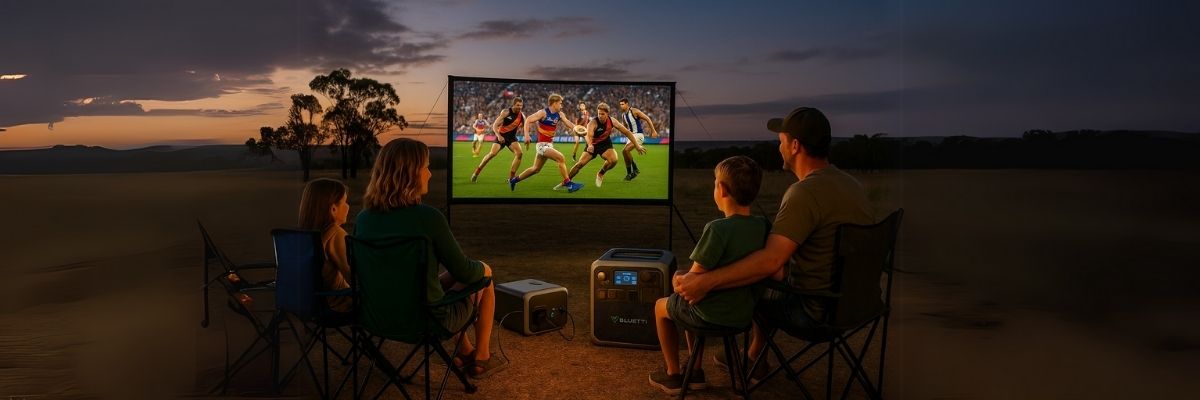
Can You Power a TV With a Bluetti?
Whether you're off-grid, camping, or riding out a blackout, Bluetti makes it easy to keep the TV on and the footy playing. Most models can power a television with no trouble — from small LED sets to large OLED screens. Here's what you need to know to pick the right unit and how long it'll keep the show running.
Not sure which power station is right for you?
Take the quiz!
Portable Power Station Requirements for TV Use
Can You Power a TV With a Bluetti in Australia
TV Power Ratings and Energy Labels
Before plugging in your Bluetti, it’s worth knowing how much power your TV actually needs. Look for a label or specification sticker on the back of the TV or in the manual. For example, if your TV says “120V 1.5A”, that equals 180 watts (120 × 1.5). That’s your starting point for power matching.
Understanding Screen Type, Size, and Brightness Impact
TVs vary significantly in efficiency. Older plasma models can draw over 300W, while modern LED or OLED sets can run between 30W and 250W depending on their size and brightness settings. Crank up the backlight and you’ll drain the battery faster.
Solar Panel for 32 Inch TV and Other Small Setups
Typical Power Needs for Small and Medium TVs
A 32" LED TV typically uses between 30–50 watts. Paired with a solar panel for 32 inch TV, even a compact Bluetti like the EB3A or EB55 can keep it powered for hours with daytime solar charging.
Matching Panel Output to Runtime Goals
To keep your TV going through the evening, consider the watt output of your solar panel and Bluetti battery size. Panels rated 120W–200W can recharge entry-level Bluetti units daily, supporting evening viewing sessions with ease.

Portable Power Station Runtime and Power Matching
How Long Will a Bluetti Run a TV?
Runtime Formula and Efficiency Losses
Use this formula to estimate runtime: (Battery Capacity × Inverter Efficiency) ÷ TV Wattage = Hours. Most Bluetti units operate at around 85–90% efficiency due to inverter energy loss.
Example: A 500Wh battery × 0.9 = 450Wh usable. If your TV draws 50W: 450 ÷ 50 = 9 hours.
Example Run Times: EB3A, AC180, AC200MAX
| Bluetti Model | Battery (Wh) | TV Wattage | Estimated Runtime |
|---|---|---|---|
| EB3A | 268 | 40W | ~6 hours |
| AC180 | 1152 | 100W | ~9.8 hours |
| AC200MAX | 2048 | 150W | ~11.6 hours |
Bluetti Power Station Model Guide
Pure Sine Wave Output and Port Safety
All Bluetti units feature pure sine wave inverters, ensuring stable and clean energy — essential for sensitive electronics like TVs. It prevents flickering or premature damage compared to modified sine wave inverters.
Matching Battery Size to TV Type
For LED and smaller TVs, EB3A, EB55, or EB70S offer great portability and runtime. For larger OLEDs or setups that include soundbars and streamers, opt for the AC180 or AC200MAX for extended runtime and added headroom.

Portable Power Station Solar Power Integration
Solar Power for TV and Lights
Daytime Charging vs Night Viewing Strategy
Using solar power for TV and lights means managing your usage window. Charge your Bluetti during the day and reserve battery power for night viewing. Adjust brightness settings and unplug non-essentials to stretch battery life.
Solar Panel for TV and Fridge Setup Tips
When powering a TV and fridge simultaneously, prioritise battery size (e.g. AC300 with B300 expansion) and pair with a 200W+ solar panel. A solar panel for TV and fridge combo works best when sun exposure is consistent and your appliances are low wattage.

You might also like:
- Can a Bluetti Run an Air Conditioner?
- Can Bluetti Be Used While Charging?
- Can Bluetti Charge a Tesla?
- Can Bluetti Jump Start a Car?
- Can Bluetti Power a House?
- Can Bluetti Power a Refrigerator?
- Can Bluetti Power a Washing Machine?
- Can Bluetti Work as UPS?
- How Long Will Bluetti Battery Last?
- Will a Bluetti Run a CPAP Machine?


